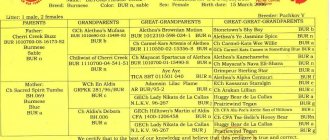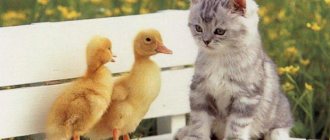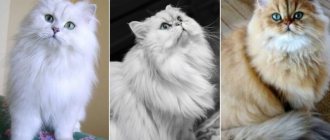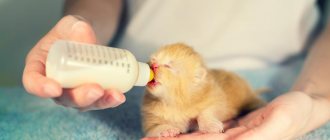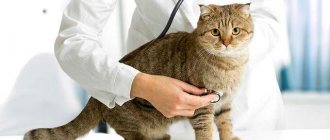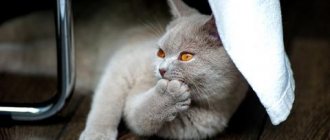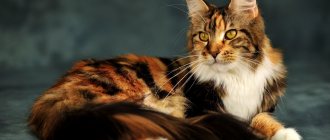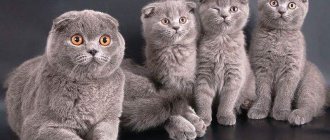Buyers usually have no difficulties purchasing a purebred pet. But choosing the right kitten with whom all family members will feel comfortable does not happen quickly. The animal pleases the owner, and the person must understand the degree of responsibility for the life and health of the pet. Who is closer to family: an important Briton or a playful Scot. To understand this issue, you need to know the difference between British kittens and Scottish babies.
History of the British and Scots
The dynasty of fold-eared beauties dates back to the 60s of the 20th century. Scotland is considered the homeland of pets with folded ears. The ancestor of unusual babies is called the cat Susie, whose litter included both lop-eared and straight-eared pets.
Representatives of British cats were brought to England by Roman soldiers. The dexterity and skills of the mousecatchers attracted the attention of the residents. Breeders were interested in the appearance of the plush cat, and at a specialized exhibition in 1871 in the capital of the country, a decision was made to breed British cats as an independent breed.
British
This aristocratic cat breed is one of the most ancient. The breeding of purebred Britons began in the 19th century, and the history of the breed began in antiquity, in the Ancient Roman era.
According to the most common belief, this breed originated from gray cats with long, sharp fangs that lived in North Africa and Southern Europe.
These cats were actively domesticated by local residents, and together with Roman legionnaires, representatives of the species that was the ancestor of the British were brought to the British Isles.
These animals were very hardy and quickly transitioned from the hot climate of the Mediterranean to the cool weather of England.
© shutterstock
Officially , G. Weier is considered the creator of the breed , who selected similar-looking gray, muscular cats for mating. He was also the first organizer of the exhibition of these animals in 1861.
Differences between the British and the Scots
Differences between the British and the Scots are observed in the formation of body parts, the cat’s character and habits.
| Peculiarities | British cat | Scottish cat |
| Pet head | Large round with pronounced cheeks, upturned nose, protruding jaw | Head proportional to the body, smaller in size than the British |
| Eyes | Wide open, large. The color is most often shades of copper. | Large, round, with an expression of surprise in their eyes. Due to the shape of the eyes it looks like an owlet. Color is the same as coat color |
| Ears | Straight, small, wide at the base | Small, erect or hanging |
| Paws | Powerful, with large pads | Medium size, strong, mobile fingers |
| Wool | According to the standard: plush, dense, short | Short, long, flowing, without clumps, with dense undercoat: depends on the breed type |
| Tail | Small or medium length, round at the end | Large, no creases, movable |
| Colors | The most common colors are around 30-35 shades. In total, more than 60 types of color are known. Main tone - blue | The color is identical to the color of the eyes, there are about 60-70 options |
External features of the British
The expression “Cheshire cat smile” will help answer the question of how British cats differ from Scottish ones. It most accurately describes the features of the British man’s appearance: large cheeks, prominent cheekbones and the same powerful head and large body.
Differences from the Scots
One of the differences between a British cat and a Scottish cat: fur. The first one has a plush, velvety, rather short one. The second is the owner of a long, pleasant to the touch, or short, thick fur coat.
External features of the Scots
The slender paws of a Scottish cat and a long fluffy tail are other ways that a Scotsman differs from a Briton. Due to the structure of the size of the limbs, a longhaired cat looks taller and slimmer. The pads of both individuals are plump with separated toes.
The head of Scottish cats is much rounder, unlike British cats, the cheeks are not so clearly defined.
Differences from the British
Scottish kittens are born with straight ears; after 3-4 weeks it becomes clear which breed the owner has in front of them. In some babies, at the age of one month, the ears begin to hang forward, towards the head, and a fold forms. This is how the hearing organs of folds are formed.
There is a misconception about the presence of British kittens with folded ears: this is not true. There are no British Folds.
British and Scottish differences in the photo
A Scottish Fold cat may give birth to babies with straight ears or bent ears. The baby with the second option, in the photo, is called Scottish Fold.
British Shorthair: features and differences
As the name of the breed suggests, these cats are from Britain. People affectionately call them “teddy bears” due to their short, thick fur.
Distinctive features of these cats:
· massive large bones;
· downed physique;
· developed muscles;
· broad shoulders.
They have a round head and developed cheekbones. This makes cats look cheeky, which makes them even more cute, but at the same time businesslike.
A massive, strong tail increases the stockiness of the breed. And short strong legs make it more squat.
British breed
Depending on the external features, there are varieties of the British breed:
- British shorthair cat, with dense coat and thick undercoat;
- British chinchilla, a cat with a unique coloring;
- British Longhaired Highlander.
The British Longhaired Highlander was the result of mating a shorthaired male with a Persian cat. From the Persians, the offspring inherited a long thick fur coat.
The British are bigger than the Scots
The weight of a British cat is greater than that of a Scottish furry representative. An adult animal reaches 7-8 kg. There are 12-kilogram pets of this breed.
Chartez and British differences
In the Middle Ages, a breed of short-haired Carthusian cat, the Chartreux, appeared in France. Outwardly, these pets are similar to British babies; inexperienced owners may mistake the Carthusian pet for a large plush pet.
The main difference between the Chartreuse and the British is the structure of the former's head, which has an elongated shape.
Other differences between Chartreuse and British:
- Chartreuse has thin cheeks.
- Its tail is wide at the base and narrow at the tip.
- Coat color: various shades of gray.
Does it make sense to pursue a career as a domestic cat?
Both British and Scottish breeds are popular and in demand. Cats with unusual colors are of particular interest. Nowadays, blue and purple colors are most widespread in Russia.
If we are talking about a show-class career, then it depends on the value of your pet as a carrier of the breed’s genes and, possibly, some particularly rare color. The purity of the genetic line is documented upon purchase, and any structural and coloring features can only be determined by an independent expert. In the future, a career is built on participation in exhibitions and prizes that the cat can receive. It is better to get advice from the regional felinological society about the intricacies of breeding and mating.
Scottish breed
The beloved Scottish breed Scottish Straights are confused with British Shorthairs. The Scots have straight ears pushed forward, the British have wide ears with rounded tips.
Differences between Scottish Fold and Scottish Straight
In turn, Scottish cats are divided into Scottish Folds and Scottish Straights. These are animals with a short coat. The ears of the folds are pressed to the head, forming a fold, this is how the lop-eared gene acts on the cartilaginous joints of pets. There is a large distance between the ears.
For straights this gap is much smaller. The base of their hearing organs is narrow.
Highland fold and highland straight differences
Highlands are considered a variety of straights and folds. Individuals appeared as a result of long-term selection work. The breed is accepted by felinologists all over the world. According to the standard, Highland Folds and Highland Straights have luxurious, long hair. Pets also have a long, fluffy tail.
The appearance and behavior of the British
What do cats and kittens of this breed look like? Strongly built, big-boned, muscular, round head, short neck - these are the standard British. Their ears are straight and of medium size, their eyes are large and round, their legs are short and strong. Representatives of this breed have short fur with a thick undercoat, which feels not so much fluffy as plush to the touch. And one more important point: a British cat is always larger and larger than a Scotsman. Those who are interested in the differences between British cats and kittens and Scottish representatives should know this.
Balanced, calm, and little talkative – these are animals of the British breed. But at the same time, they always stand up for their owner and are devoted to the house. In case of impending danger, they can rush into battle. These cats get along well with a variety of pets. Little kittens are funny and funny, affectionate and playful. Children especially like them.
Difference in character
Typically, British pets are purchased by working people who spend a long time outside the home. Plush pets can be alone in the apartment without fear of loneliness. Importance, aristocratic behavior and sedateness - these qualities distinguish the British from other breeds.
Animals do not like to be picked up or squeezed. The cat itself will approach the owner for a portion of affection. The British are prone to depression, cats need to be interested in active games. Representatives of this breed quickly gain weight; it is important to prevent British pets from becoming obese, especially after castration or sterilization. Extra pounds are an additional burden on the internal organs of pets.
The Scots are easier to communicate with people and other animals. Playful, playful cats resemble dogs in their habits: they can fetch an object thrown by the owner, hide, and frolic with other kids. Scottish dogs are more amenable to education and training. They quickly acquire hygiene skills.
Representatives of the breeds are very clean animals; they will refuse a dirty tray and will not eat from dirty dishes. If they feel unwell, their behavior will attract the attention of family members to their problems. Scottish and British cat in the photo.
Differences in habits and behavior
Differences in appearance are not the only way to recognize representatives of different cat breeds, in our case – British and Scottish. There are also many differences in the behavior of pets. Both have special habits that distinguish one breed from another.
Many cat lovers even choose the breed of their pet not based on external differences, but on character. During the process of evolution, animals developed behavioral habits.
The behavior of animals largely depends on the conditions in which their ancestors grew up.
Behavior and sociability
The British are true aristocrats. In games, they prefer to be carried in their arms, but they themselves are reluctant to run after a bow. Their massive body structure is not adapted to fast movement, but they can jump high.
British/Scottish mix
Initially, breeders bred British and Scottish representatives of the breed. But over time, breeders noticed: such a union produces weak babies with genetic diseases of the spine and joints.
Currently, cross-breeding between Britons and Scots is prohibited. A conscientious owner will not allow the appearance of sick offspring. To get healthy kittens, Scottish Straights are bred with Scottish Folds. The best result is considered to be mating provided that partners of the same color and from the same felinological club are selected.
You also cannot cross fold-eared cats with a fold-eared cat. The presence of the lop ear gene will lead to diseases in the born kittens.
Crossbreed with mestizo
Mating with a mixed breed spoils the breed's advantages; such pets are not exhibited at shows and felinological organizations do not breed them.
Health problems in Scottish and British cats
Both Scottish and British pets are not prone to infectious diseases. With good care, they rarely get sick. Like many purebred cats, they have genetic diseases associated with the structural features of the breed:
- The British have powerful and heavy bones, so they often have diseases associated with the spine, there may be deformities of the paws (tarsus or carpal bones), bone growths on the fingers - such diseases can be identified using x-rays, and a cause for concern is the lameness of a pet or his nervous reaction to stroking his back;
- the structural features of the chest and nasal cavity of the British can lead to the appearance of heart disease in adult animals - shortness of breath is a sign, but for a more accurate diagnosis, an annual ultrasound is recommended;
- The Scots have a body structure similar to the British, and their legs are longer and thinner, so they often have joint diseases, which can also lead to lameness;
- Heart cardiomyopathy also occurs in Scots, as in British cats, and kidney and gastrointestinal diseases are often diagnosed in this breed.
When monitoring the health of your pets, you need to pay attention to the above signs more often. It is important to adhere to preventive recommendations:
- exclude infection with internal and external parasites;
- Vaccinate the animal on time;
- maintain a balanced diet, avoiding obesity, which can provoke any of these diseases.
Otherwise, caring for a British or Scottish cat is the same as for representatives of other breeds.
Video: genetic diseases associated with the structural features of British and Scottish cats
Who is better to choose
It is difficult to say which breed is better, British or Scottish. The choice of a pet is based on the preferences of the future owner, daily routine and rhythm of life. The British cat quickly becomes attached to the house and considers himself a full member of the family. He likes to be left alone for a long time, but a purebred animal needs proper care and timely education.
The British man’s appearance is brutal, his behavior is very important. It is no coincidence that previously only the rich segments of the population could afford to keep such cats. The facial expressions of pets are interesting and funny. Up to a year old, babies are playful and active, but closer to the age of two, the cat’s habits change, she becomes calm and sleepy. The baby loves to sleep, lounging on the plush back.
The Scottish cat, as a kitten and as an adult, is playful and noisy. He will run around at night or run around the apartment with a rubber mouse.
The Scottish woman loves children, she likes the attention of the owner and family members. Everything in it is for a large and noisy company:
- A funny pose in which your pet often sits: on its tail, with its long legs outstretched.
- Or the famous gopher stand, when the baby stretches vertically on its hind legs, tucking its front legs.
- Ability to walk on a leash and follow various commands.
This cat combines the qualities of cats and dogs. Caring for a cat is not difficult. The Scottish favorite cannot stand heights: flying from the top shelves is not possible for the animal due to the structure of its limbs.
How to distinguish a British kitten from a Scottish one
The difference between British and Scottish cats is obvious. It makes no sense for nursery owners to deceive those who want to buy babies of a certain breed.
The smaller the kitten, the more difficult it is to distinguish a British cat from a Scottish pet. Characteristic signs appear as the baby grows older. Therefore, it is better to buy a baby at the age of 2-3 months.
By this time, the Scotchfold ears, straight from birth, will acquire the desired fold. The eye color will gradually begin to acquire a constant shade that matches the color of the animal's coat. A mandatory item when choosing a kitten is to check the baby's tail: for a fold-eared baby, it should be long and mobile. The British have a powerful, thick tail, much shorter than that of the Scot.
The main points of difference between kittens of the British and Scottish breeds, which people pay attention to when choosing babies:
| British kittens | Scottish kittens |
| Heavier paws, clubfoot when walking | Long light limbs |
| Chubby cheeks | Cheekbones are not very pronounced |
| Large baby | Small in size |
| Round head | Elongated skull shape |
Babies do not differ much in their habits: up to a year old, representatives of these breeds are active and respond to play with pleasure. The difference in behavior between the British and Scottish cats will be noticeable in later life.
To the touch, the Scottish have fur that is more fluffy and soft, gliding, while the British have dense and thick fur. An inexperienced buyer will not be able to independently determine what breed the cub belongs to. The difference in behavior between the British and Scottish cats will be noticeable in later life.
Differences between British cats and kittens and Scottish ones: appearance, character and more
Natalia:
03/09/2016 at 07:25
Dear Elena! THANK YOU SO MUCH FOR YOUR ANSWER!!!!!!.. Very Useful Information!.. So, I’m right, I’m just instinctively afraid to take her to a cat so that she gets pregnant (I just thought all the time that she might NOT survive RODOV)!!!.. And you confirmed my assumption!.. I am very grateful to you for your response!!!!!!.. It was so interesting to READ your story about your 3 (!!!) folds girly!!!.. Very similar (in the main features) are all the character traits of these Wonderful Scottish Fold Cats!!!.. I once, when I was still in school, lived at home with an ordinary (as if outbred) light-colored a red CAT named “CAT”, who lived in our apartment, but walked in the yard and along the streets freely when he wanted (sometimes he disappeared for 2-3 days, and then returned to us, all beaten, injured, - he healed “combat "wounds)… I found him when I was only 7 years old in the yard, in front of my entrance (or rather, he found me himself - he just came up to my feet (it was early winter outside, it was cold, but he was a small (no more than 1 month old) kitten, and asked, squeaking, to be held in my arms.. I was wearing a drape coat (a first-grader). I was returning home from school... And then I took him in my arms (this little red-haired lump)... And he began to lick my COAT exactly in the place where adult women have breasts.. And he licked him so diligently that a BIG Lump quickly formed on my coat. WET SPOT!!!.. And I couldn’t resist taking him to our home (before that we didn’t have any cats or cats... Quite a few of us lived in the apartment then (me, my mom and dad, my grandparents by dad, and even great-grandmother (grandmother’s mother, i.e. my dad’s grandmother)... Of course, at first they asked me to give up this idea - to place this kitten with us... But then they finally agreed... They just said that only I would take care of him (and feed him, and bathe him, and play, etc.) And I was so glad!.. Needless to say, very quickly our whole family fell in love with this very lively red-haired “bandit” of ours. , that we even began to “fight” a little for his love!.. He lived with us like a TSING!.. He will eat, sleep, play, and, when he wants, ask to go for a walk... In the courtyard of a large multi-entrance 5-story building (Rostov-na -Don)... And there, in our so to speak “cat yard”, HE was the “Chief Bandit”, “Singer” and “Ringleader”!.. And also, so to speak, the “Chief MACHO” (among all the CATS of our yard! (Gradually, in our yard there were more and more cats and kitties of a red color (although our CAT himself was not bright red, but such a gentle muted shade (it seemed to us that his color resembled the color of good butter).. He was quite a large cat (weighed 4-5 kg)!!!.. He always slept (when he spent the night at home) only with me (we even kissed secretly from everyone)... How many injuries did we heal for him!.. This is a nightmare!.. He was such a fighter in the yard... When he returned home, he simply stood near the front door of the apartment and waited for one of the neighbors to pass by and, seeing him, press the bell button!.. He had a bad habit: he was VERY LOVED Valerian (he pulled it from my great-grandmother’s bedside table, unscrewed the lid with his paws, rolling the jar on the floor, and then licked the droplets flowing from the jar with his tongue)... And then he went on a rampage: he pushed and overturned chairs, jumped on cabinets and jumped with them on us, etc. (having fun) ... But we all ADORE him: He was a Personality, so to speak (one could say the Godfather of our yard cat “brother”).. And it had to happen that one day it was his passion to valerian and it ruined him at the age of about 9 years: he mixed up the jars in my great-grandmother’s bedside table - instead of valerian, he began to lick TURPENESS (rubbing) (and there is also ALCOHOL in there).. We later established this.. And it was like this... One day he somehow strangely unusually slowly and hesitantly walked along a serpentine path to the front door to ask to go into the yard (he only went to the toilet in the yard)... I noticed that he was somehow unusually SLEEPY... But somehow I didn’t notice meaning... He came out and began to slowly go down the stairs and down the entrance... I continued to do my school homework... I was already in the 10th grade at school... And suddenly someone rang our doorbell... I opened it... And the neighbor he told me that our cat vomited right at the entrance, and he was lying motionless next to him on the ground... I ran downstairs and saw that he was no longer breathing!.. He poisoned himself!!!!!!.. It was like that for me and A TRAGEDY for all of us!.. It’s hard to describe!.. I didn’t just cry, I sobbed loudly for several days!!!.. I have no brothers or sisters... It seemed to me that I had lost my BROTHER!!!.. He could live for at least another 5-6 years, or even more... He was so ACTIVE, so combative!.. He survived so many terrible INJURIES!.. And he died so absurdly!.. With this story I wanted to emphasize how everything CATS and CATS are all DIFFERENT!!!.. Not only does each breed have its own characteristics, but also each individual Cat (or Cat) has its own unique character!.. And how we all love them, how attached we become!.. They are like that sincere, real!!!.. Once again - Thank you very much, Dear Elena, for your Response to my Comment, for your answers to my questions!!!.. I wish you all the best! And I would be very HAPPY to talk with you again!!!.. If you want, you can write to me at my email: [email protected] . Or WRITE here - whatever is convenient for you!!!!!..
Answer
British or Scottish: the choice is yours
People are thinking about buying a specific pet and note important conditions for their choice. They take a cat to a large family with small children or to a busy person who works a lot and loves silence in the house. Or maybe a son or daughter will just like the fat-cheeked baby Briton, and all family members will support the freedom-loving animal.
Whether a playful Scottish pet or a British cat comes to the family: every animal needs care. Information about the external characteristics, character and behavior of animals will help you decide on the choice of your baby.
Lovely Scots (Scottish fold)
The Scottish Fold cat was bred forty years ago, namely in 1961. This happened in Scotland. And several hundred years before this event, the first mentions of cats with curved ears that lived in China appeared. The reason for the birth of a cat with such an unusual ear structure was a gene mutation.
What is special about the appearance of representatives of the Scottish Fold breed, why do you have to think about how the British Fold differs from the Scottish Fold?
Animals of this breed have a strong build, short massive paws and a short neck, thick wool, soft to the touch. Of particular value are the ears. The more they are curved and the more they cover the ear opening, the better and more expensive representatives of this breed are considered. It is what ears the kitten is born with that determines which group it will belong to: show, breeding or domestic. It is curious that Scottish Fold kittens can be born with eyes of different colors.
What is the difference between a British Fold and a Scottish Fold cat? Special ears
When kittens are born as a result of mating between straight-eared British and fold-eared Scots, it is not yet possible to determine what kind of ears they will have. The time from birth to four weeks is the longest for a breeder. During this period, the ears are formed, and it will soon become clear which kittens are produced: Scottish Folds or Scottish Straights. This is how the Scottish cat differs from the British cat. Scottish Folds do not immediately acquire their special ears. At the same time, the British can only be straightforward.
Up to six weeks, kittens' ears are considered fully formed. But their bend in Scottish folds also varies. If it is simple, then the tips of the ears are only slightly tilted forward. When double and triple folded, they fit tightly to the head, like a cap. This option is the most desirable for the breeder. It is these kittens that often become winners of various cat shows.
British and Scots: comparison of characters
Despite common ancestors, cats of related breeds differ greatly in behavior. Therefore, this is what you should start from when choosing a pet.
1) The British are calmer. They don't like active entertainment. Long caresses are also not about them, so it’s rare that my lord or milady will sit on the owner’s lap and not run away somewhere.
The Scots, on the contrary, completely frolic. They love children very much and you can cuddle them for hours, as the cat only experiences genuine pleasure. Thus, for a family with children, the Scottish Fold is probably better suited.
2) Both breeds do not show aggression. In the event of a stressful situation, both types of cats do not rush at the offender, trying to bite and scratch him, but run away and hide in hard-to-reach corners. This quality is also suitable for families with children. Because the owners can be sure that the pet will not harm even the most daring child in handling the cat.
3) An interesting behavioral feature of Scottish cats is that they periodically stand on their hind legs and stand like that for some time. This is by no means fun for the cat, but a procedure necessary for its health, because in this way the animal straightens its spine. They also like to sit on their hind legs, like brave watchdogs.
3) Not all cats like to climb up. An example of this is the Scots, who never sit higher than the windowsill. Representatives of a related breed, on the contrary, behave in this regard, no different from other desperate brothers: they climb anywhere and are very fond of heights.
So, a cat’s character plays an important role, so in order for the animal not to cause concern to the owner, when choosing a pet, you should focus not only on appearance, but also on behavioral characteristics.
